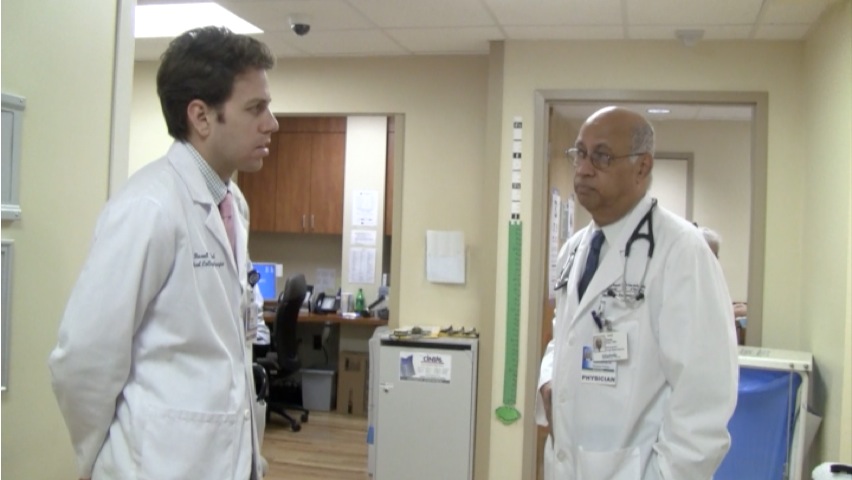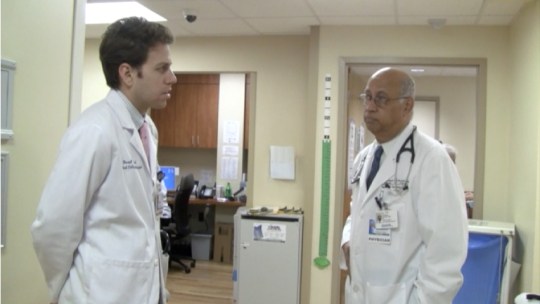Emergency medicine is unique.
At any time of the day or night, practitioners in an ER must be ready to treat any kind of problem, said Dr. Sam Kini, a veteran emergency physician. Patients rush in with everything from chest pains to vaginal discharge. Among the common problems are back pains, abdominal cramps, fevers, bruises and sprains.
Kini, who now teaches and supervises fourth-year medical students at the Georgia Regents University-University of Georgia Medical Partnership in Athens, said the ER is a blend of specialties, and that makes it an invaluable place to teach.
“We see patients with all kinds of complaints, and we want the students to have that experience of just seeing all patients, all types, all ages, all hours of the day and night,” he said.
In 2010, Medicaid patients made up the majority of ER visits in Georgia, according to state data. The American College of Emergency Physicians (ACEP) said it expects ER visits to increase nationwide as the Affordable Care Act triggers Medicaid expansion in a number of states. (About half the states, including Georgia, have opted not to pursue expansion.)
“Increasing the number of patients on Medicaid without an equivalent increase in the number of physicians willing to take that insurance will surely increase the flood of patients into our nation’s ERs,” former ACEP board President David Seaberg said in a statement.
Emergency medicine has grown in popularity among graduating medical students. Data from the Association of American Medical Colleges showed that the average of emergency medicine residency applications increased from 28 percent in 2010 to 31 percent in 2011. In 2012, the number increased to 35 percent.
Yet Kini said that only five of his 40 students plan to complete an emergency medicine residency after graduating in 2014.
Georgia was reported to have a shortage of emergency physicians in 2008. As of 2012, the state had an estimated 1,110 emergency doctors, while Michigan, a state with a similar population, had twice that number, according to Kaiser Family Foundation data.
During their fourth and final year of medical school, students have three required, month-long clerkships, also called rotations, to complete in addition to three electives and a sub-internship. Students spend one day each week in the classroom and up to four days at hospitals throughout northeast Georgia.
The emergency medicine rotation will be valuable to students regardless of what specialty they choose or where they practice. An emergency can happen anywhere,
including in a routine medical setting such as a physician’s office or an orthopedic clinic. When patients experience frightening symptoms — such as chest
pain or sudden numbness — they expect physicians to know how to react.
Fourth-year medical student Bree Berry completed her emergency medicine rotation at Eastside Medical Center in Snellville. She was barely into her second week there when she had an unexpected but unforgettable experience.
“On Labor Day I saw a guy who had an accident with his table saw and nearly amputated [all] five of his fingers on his right hand,” Berry said.
Berry plans to go into primary care, so she probably won’t see such severely injured patients often, but she recognizes how the rotation will be useful to her.
“Since I don’t plan to be working in an emergency room, I think it will be valuable for me to know which patients I need to send to the emergency room,” Berry said, “and which I can safely treat in my office.”
Surprises can teach good lessons
Some patients who come into an ER have valid emergencies, while others misuse the ER as a replacement for primary care. This is one reason why emergency physicians never really know what to expect from the unscheduled patients who come through their door.
[youtube]http://www.youtube.com/watch?v=Apx8u9HiHgo&feature=c4-overview&list=UUtg_U8UWdu_fZrvFlVwyXrA[/youtube]This element of surprise may be frightening for some medical students, but for Xiao Li it was exciting and helped him grow as a physician. He said he enjoyed knowing only a name and an age when first entering a patient’s room.
“When it comes to emergency medicine, what I like most about it is that you never know who or what’s coming in,” said Li, who completed his clerkship at St. Mary’s Hospital in Athens and plans to specialize in radiology.
At least once a week, Kini visits his students at their rotation site to note their progress and assist ER physicians with teaching. He and the ER physicians teach students to recognize common and serious diseases and order the appropriate tests. Students also learn how to determine the correct treatment and decide which patients need to be admitted to the hospital and which can go home.
When Kini works with a student in the ER, he lets the student take the medical history and perform a physical examination first while he asks the student questions about the procedure.
Once the student has completed these tasks, Kini will perform the same tasks on his own, while the student notes the differences in the way Kini handled the patient. Afterward, the two go outside the patient’s room to exchange thoughts and notes privately.
Kini said playing the role of both student and instructor helps students appreciate what they did right as well as understand what they should have done differently. He said when students recognize why he asked certain questions that they did not, they are able to learn from their mistakes.
“It gets the student to think, as to why I asked this question [and] why they missed it,” Kini said, “and they won’t miss it in the next room.”
April Bailey is pursuing a master’s degree in health and medical journalism at the University of Georgia. She currently holds a bachelor’s degree in print journalism from Middle Tennessee State University.


